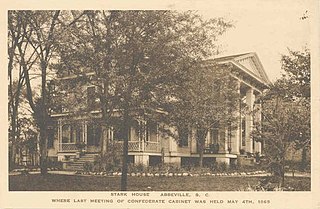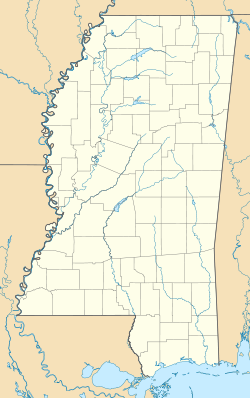
Greenville is the ninth-most populous city in the U.S. state of Mississippi, and the largest city by population in the Mississippi Delta region. It is the county seat of Washington County. The population was 29,670 at the 2020 Census.

Shelby Dade Foote Jr. was an American writer, historian and journalist. Although he primarily viewed himself as a novelist, he is now best known for his authorship of The Civil War: A Narrative, a three-volume history of the American Civil War.

Chippokes State Park is a Virginia state park on the south side of the James River on the Captain John Smith Chesapeake National Historic Trail. In addition to forests and fossil hunting on the beach, it includes three historic houses as well as an open-air agricultural and forestry museum with seasonally appropriate events. Other recreational facilities include a visitor center, swimming pool, hiking trails, cabins, yurts and campgrounds). As of 2020, the yearly visitation was 173,110. It is located at 695 Chippokes Park Road, in rural Surry County, Virginia off Route 10.

The Judah P. Benjamin Confederate Memorial at Gamble Plantation Historic State Park, also known as the Gamble Mansion or Gamble Plantation, is a Florida State Park, located in Ellenton, Florida, on 37th Avenue East and US 301. It is home to the Florida Division United Daughters of the Confederacy (UDC).

William Thomas Sutherlin was a tobacco planter, distributor, industrialist, Confederate quartermaster and politician. He served as mayor of Danville, Virginia (1855–1861), as its delegate to the Virginia Secession Convention of 1861 and later for one term in the Virginia House of Delegates (1871–1873) Sutherlin's plantation home became the temporary residence for President of the Confederate States of America Jefferson Davis and his Cabinet from April 3 – April 10, 1865, the week before Gen. Robert E. Lee surrendered the Army of Northern Virginia at Appomattox Courthouse.

Ward Hall is a Greek Revival antebellum plantation mansion located in Georgetown, Kentucky. The main house covers 12,000 square feet (1,100 m2), with 27-foot (8.2 m) high Corinthian fluted columns.

The Burt-Stark Mansion, also known as Armistead Burt House, in Abbeville, South Carolina was the site of the last Council of War of cabinet members of the Confederate government. On May 2, 1865, Jefferson Davis, hoping to continue the struggle, met unanimous opposition and realized the Confederate independence cause was lost.
A Mississippi Landmark is a building officially nominated by the Mississippi Department of Archives and History and approved by each county's chancery clerk. The Mississippi Landmark designation is the highest form of recognition bestowed on properties by the state of Mississippi, and designated properties are protected from changes that may alter the property's historic character. Currently there are 890 designated landmarks in the state. Mississippi Landmarks are spread out between eighty-one of Mississippi's eighty-two counties; only Issaquena County has no such landmarks.

The Chapel of the Cross is a historic Episcopal church in the Mannsdale area of Madison, Mississippi. The brick structure was built circa 1850–52 by enslaved people. It is noted for its Gothic Revival architecture, which draws heavily from 14th-century English country churches. It was added to the National Register of Historic Places in 1972.

Lakeport Plantation is a historic antebellum plantation house located near Lake Village, Arkansas. It was built around 1859 by Lycurgus Johnson with the profits of slave labor. The house was restored between 2003 and 2008 and is now a part of Arkansas State University as a Heritage site museum.

Annandale Plantation was a cotton plantation worked by enslaved laborers in what is now the Mannsdale neighborhood of Madison, Mississippi.
The Civil War Trust's Civil War Discovery Trail is a heritage tourism program that links more than 600 U.S. Civil War sites in more than 30 states. The program is one of the White House Millennium Council's sixteen flagship National Millennium Trails. Sites on the trail include battlefields, museums, historic sites, forts and cemeteries.
Linden is a historic mansion in Glen Allan, Mississippi.

The Junius R. Ward House is a historic house and former Southern plantation in Erwin, Mississippi.

Hezekiah William Foote (1813–1899) was an American Confederate veteran, attorney, planter, slaveholder, and state politician from Mississippi.
Huger Lee Foote was an American planter and politician. He served in the Mississippi Senate. He later sold his plantations to pay for his gambling debts.
Foote is an unincorporated community in Washington County, Mississippi, United States. Variant names include Colmere and Dudley.
Margaret Johnson Erwin Dudley (1821-1863) was a Southern belle, planter and letter writer in the Antebellum South. The owner of Mount Holly from 1854 to 1863, she was one of the largest slaveholders in Mississippi. She freed her slaves in 1858, prior to the beginning of the American Civil War.
Lycurgus Johnson (1818–1876) was an American cotton planter and large slaveholder in the Arkansas Delta during the antebellum years. Born to the powerful political and planter Johnson family in Scott County, Kentucky, he became the owner and developer of the Lakeport Plantation in Chicot County, Arkansas. It bordered the west bank of the Mississippi River.
Walter Sillers Sr. was an American lawyer, politician, businessman, and planter in Mississippi. He played a significant role in the economic, agricultural, and political culture of the Mississippi Delta region. A cotton planter, he was an advocate for the establishment of crop control policies for the Southern United States through the development of planter's cooperatives. He was a key figure in the Mississippi Democratic Party and was responsible for the construction of levees in the Mississippi River Valley.














